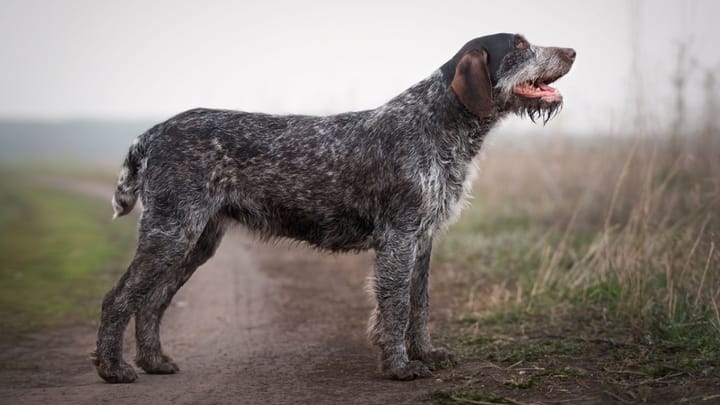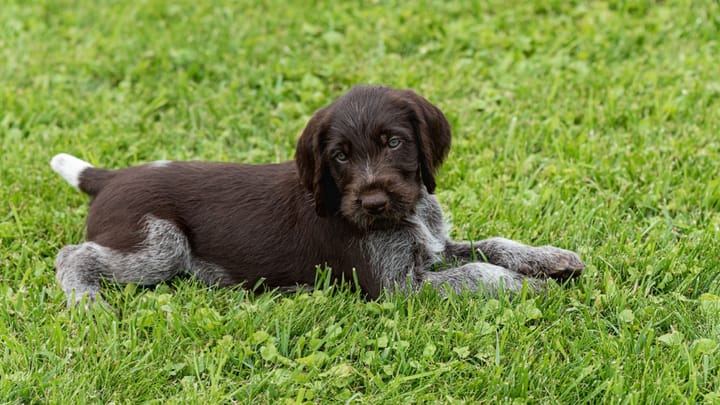German Wirehaired Pointing Dog
Other names : Deutsch Drahthaar, Drahthaar


Bred during the late 19th century, the German wirehaired pointer is a hardy, versatile working dog. He is a highly intelligent bred that responds well to the right kind of training methods. However, first-time owners may struggle to keep these independent animals focused. The German wirehaired pointer is very social and thrives off the company of other dogs and humans. This high-energy breed needs plenty of vigorous exercise and is better suited for owners with an active lifestyle and access to rural areas. Not really suited inner-city urban life.
|
Life expectancy |
The German Wirehaired Pointing Dog has a life expectancy of between 13 and 15 years |
|
Temperament |
|
|
Size |
Medium
|
|
Adult size |
Female
Between 22 and 25 in
Male
Between 24 and 27 in
|
|
Adult weight |
Female
Between 55 and 66 lb
Male
Between 55 and 66 lb
|
|
Coat colour
Liver, roan, brown, liver and white, black and white. |
Brown |
|
Type of coat
Short and wiry. Double coat: dense, insulating underlayer and a short, wiry topcoat. |
Hard Long |
|
Eye colour
Dark brown. |
Brown
|
|
Purchase price |
The German Wirehaired Pointing Dog costs between £610 and £745 |
Pointers are excellent swimmers. In fact, they have webbed feet. Their swimming abilities made them excellent dogs for tracking and recovering water birds.
Although they’re becoming a more popular choice for pet lovers, the German Wirehaired Pointer still plies its trade as a working dog in Germany and other parts of Europe.
These dogs are very smart. If handled incorrectly, they can soon become very willful, stubborn, and difficult to control.
More details about the German Wirehaired Pointing Dog
German Wirehaired Pointing Dog: Origins and history
You won't be surprised to know that the German Wirehaired Pointer was first bred in Germany. Its origins can be traced back to the late 1800s, where a small group of breeders and hunters decided to create a strong, versatile hunting companion. Although there's some disagreement as to the exact lineage, it's commonly accepted that the Pointers ancestors include the pointing griffon and Pudelpointer.
Physical characteristics of the German Wirehaired Pointing Dog
The German Pointer is a well-balanced, handsome dog with a distinct wiry coat and a tuft of facial hair which resembles a well-groomed beard. They have lean, muscular frames with powerful hindquarters and broad shoulders. The German Pointer has an alert, athletic posture with a high and proud looking head carriage.
FCI classification of the German Wirehaired Pointing Dog
-
Group 7 - Pointing Dogs
-
Section 1 : Continental Pointing Dogs
German Wirehaired Pointing Dog: Characteristics
German Wirehaired Pointing Dog: Behaviour
Training a German Wirehaired Pointing Dog
This depends on how much experience you have of dealing with highly intelligent dogs. Although a certain level of intelligence makes training a dog much easier, very intelligent dogs can pose a challenge to the novice dog handler. Intelligent canines are also very strong minded and will often engage in "naughty" behaviour if they're not being stimulated or challenged in the right way. If you've never trained a dog, do lots of research before taking on the challenge of a German Pointer.
German Wirehaired Pointing Dog: Lifestyle
Breed compatibility German Wirehaired Pointing Dog
German Wirehaired Pointing Dog: Purchase price
A purebred German Wirehaired Pointer and registered at the Kennel Club can cost up to £745. For a dog not registered at the Kennel Club, the average price is £610.
You’ll need to budget between £50-70 each month to cover the cost of high-quality dog food. Other expenses, like insurance, will vary depending on your dog's age and medical history. Overall, maintaining a healthy Pointer will cost around £1200 per year.
German Wirehaired Pointing Dog: Shedding
Average
These dogs are not prone to suffering from any specific medical conditions that cause hair loss.
German Wirehaired Pointing Dog: Grooming
Pointers shed their coats during spring and autumn. Apart from that, they're fairly low maintenance when it comes to dog grooming. However, you will need to give their beard a trim, as well as giving it a quick wipe after mealtimes.
German Wirehaired Pointing Dog: Health
The average lifespan for a German Wirehaired Pointer is between 13-15 years.
German Pointers have strong, athletic bodies and a solid constitution. They’re not the biggest dogs in the world, but they're certainly one of the toughest and most determined. These dogs were bred to track and hunt in some of Europe's most inhospitable environments, including dense forest areas and the mountainous regions in and around the Alps.
Pointers shed their coats during the warmer times of the year. However, it may need an extra trim during particular hot summers. Even when the weather is really hot, these dogs still need their exercise. Keeping their coats nice and short will prevent them from overheating.
Their thick, insulating undercoat keeps the pointer warm during the coldest months. They also have a wiry outer coat which is pretty much water resistant. In other words, a German Pointer is well equipped for dealing with harsh weather conditions.
They do have a tendency to put on a few extra pounds as they get older; you may need to adjust their food intake to keep it in line with reduced activity levels.
- Hip dysplasia
- Bloating
- Exercise induced collapse
- Haemophilia B Factor 1X Deficiency
- Junctional Epidermolysis Bullosa
Do you want a German Wirehaired Pointing Dog dog ?
Oh no...
There are no German Wirehaired Pointing Dog adoption profiles at the moment...




